Taking a deeper look at the Padres rotation after first month
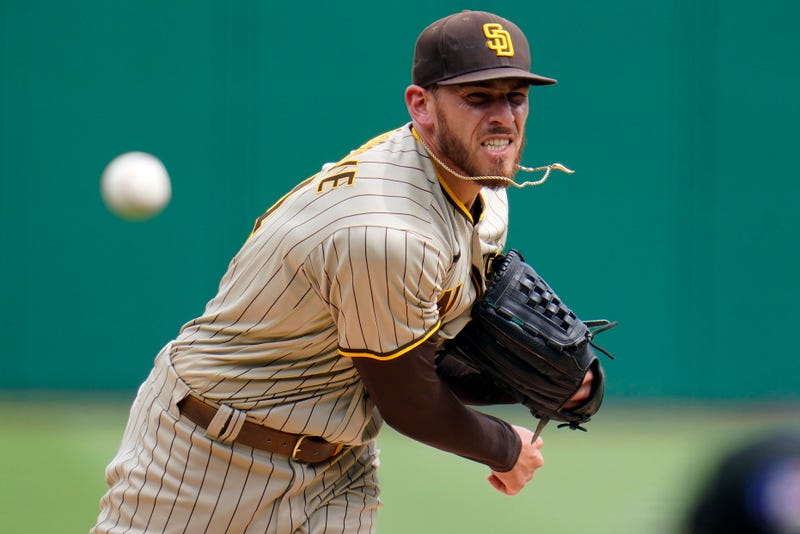
Credit: AP Photo
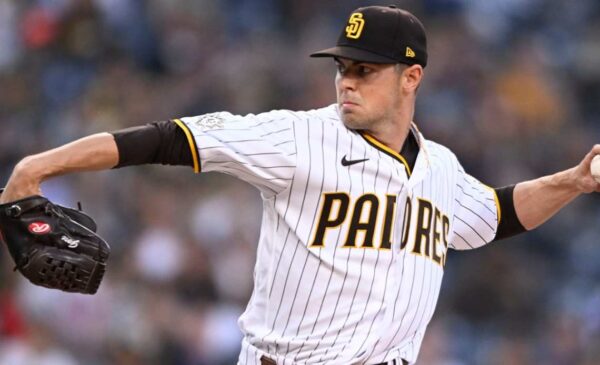
After one month of the 2022 season, the San Diego Padres are performing at or around how many expected. The team’s 15-8 start can be largely attributed to consistent showings of good starting pitching and defense and, outside of last week’s feasting on below-average pitching, less consistent offensive production.
After a 2021 season that saw the Padres falter massively down the stretch due mainly to a glaring lack of depth in the starting rotation, the returns from the 2022 starting rotation have been much more positive. Currently, the Padres starting pitchers have pitched to a 3.13 ERA, good for seventh in all of baseball. Last year, Padres starters combined for a 4.54 ERA, which only ranked 18th.
However, through this point last season, Padres starters ranked third in baseball with a 2.81 ERA and 3.4 WAR. Therefore, it’s fair to proceed with some caution after the mirage of the first half of 2021.
While it might be unfair to ask the Padres’ starting staff to continue this same level of elite production throughout the 2022 season (their 3.13 mark would have ranked them tied for 2nd in baseball last year), the team will arguably need to continue to receive quality starting pitching, if nothing else due to the middling offensive results for the team thus far. Outside of hot starts from Manny Machado, Eric Hosmer, and Ha-Seong Kim, the Padres offense has been below average. They currently rank 16th in the league in batting average (.234), 15th in Slugging Percentage (.376), and 12th in OPS (.702), much of which has been buoyed by these three players.
Is the team’s quality starting pitching sustainable? Let’s take a deeper look at each one of the Padres’ current starting pitching options, and their prospects for the rest of the 2022 season:
Yu Darvish (2-1, 4.44 ERA)
By all accounts, Darvish has pitched similarly to the ace-caliber production he is familiar with outside of an ugly start in San Francisco, which saw him give up eight earned runs in a career-worst 1
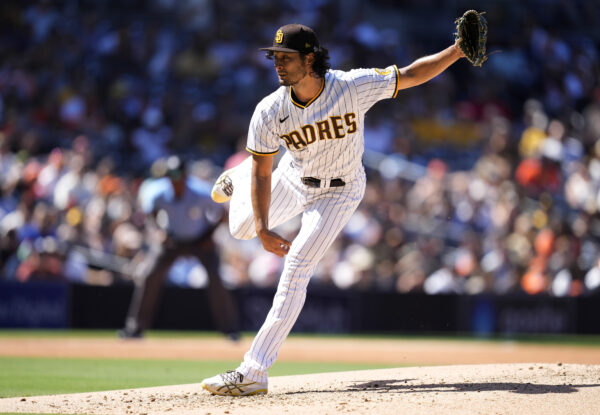
2/3 innings. Take away that start, and Darvish has allowed only five earned runs over the course of 24 2/3 innings so far in 2022. This is what the Padres need to see from the top of their rotation if they want to make a deep playoff run, and it’s helped to ease some of the concerns raised over Darvish’s end to 2021.
While he started last year with a 7-3 record and 3.08 ERA through his first 18 starts in 2021, Darvish limped through the rest of the season, only winning one game and posting an ERA north of six. Darvish’s advanced age (35), troubles with a balky hip, and MLB’s crackdown on foreign substances in June may have all been contributing factors to Darvish posting his worst ERA and strikeouts per nine innings since 2018 with the Cubs.
While Darvish’s strikeout numbers have further dipped so far this season (8.5 K/9 in 26 1/3 IP), he has retained excellent spin on his fastball and limited barrels, according to Baseball Savant. His fastball velocity has also ticked up from an average of 94.5 mph in 2021 to 95.0 mph in 2022.
League-wide concerns about Darvish’s durability and the sharpness of his stuff will continue to persist throughout the season, if nothing else, because of how his 2021 ended. Darvish will make a combined $37 million across this season and next before becoming a free agent after the 2023 season.
Sean Manaea (2-2, 3.60 ERA)
In his five starts with the Padres since being acquired from the Oakland Athletics just before Opening Day, Manaea has pitched about as well as expected. His 3.60 ERA and six innings per start are right around his career averages and have been a boost to the San Diego rotation.
What’s more, Manaea has chipped in four of San Diego’s MLB-leading 13 Quality Starts so far this season.
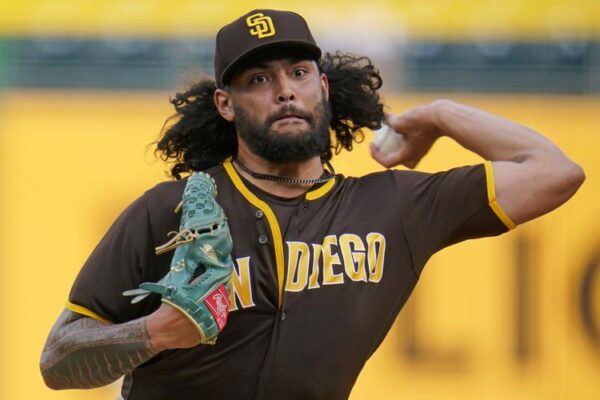
Being only 30 years old and a free agent after the 2022 season, Manaea will likely command a multi-year deal with an AAV of around $20 million, especially with Scott Boras as his representation. While the Padres would love to retain his services after the season, he may price himself out of their range with their current bloated payroll and salary obligations elsewhere.
Still, Manaea has provided value in his limited time thus far, and career numbers indicate that his consistent start isn’t a mirage. His 32 starts and two shutouts in 2021 paced the league and should remain through this season. While his peripherals may suggest otherwise (low fastball/breaking ball spin, low whiff rate), Manaea has proven able to get outs by limiting hard contact and minimizing damage with runners on base.
Joe Musgrove (4-0, 1.97 ERA)
Musgrove has gotten off to the best start of any Padres starter this season and is poised to have one of the best seasons by a Padres starter since Jake Peavy‘s Cy Young-winning season in 2007. He
currently leads the Majors in Quality Starts and is second in Innings Pitched and posting a mind-boggling 16.5 K/BB rate.
While it’s unlikely Musgrove continues to limit his walks so efficiently, it’s encouraging to see such a positive jump from his career rate (3.94). Should he continue to pitch like an ace this season, that’ll be one of the big reasons why.
The biggest questions surrounding Musgrove are his plans for after the 2022 season. While he can become a free agent after this season, the Padres have reportedly tossed around the idea of a contract extension to keep him in San Diego long-term. Even though Musgrove is a San Diego native, he’s still more than willing to earn his worth on the market after turning down an extension somewhere in the range of $88 million over eight years (as reported by The Athletic‘s Ken Rosenthal).
While the Padres would be wise in extending Musgrove’s contract and ensuring some stability in their rotation for 2023 and beyond, Musgrove’s durability could become an issue. Though he’s only 30 years old, throwing sliders 30% of the time could take its toll on his right elbow. Regardless, Musgrove is emerging into a true ace and is a breakout candidate for the rest of 2022.
MacKenzie Gore (2-0, 1.71 ERA)
Gore has had one of the more turbulent development paths of any top prospect in recent memory. After dominating the California League in 2019 with a 1.02 ERA and 12.5 K/9, there were
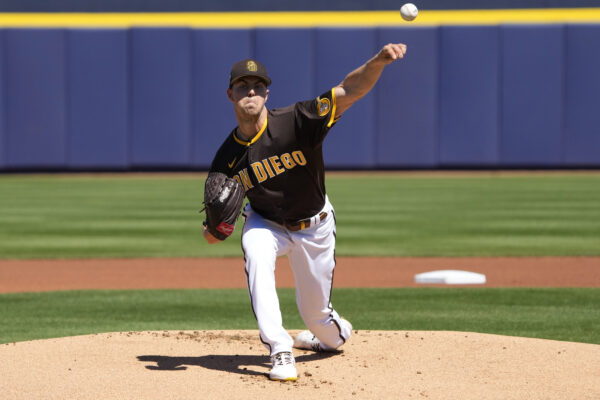
whispers that Gore would make his MLB debut as soon as the 2020 season.
Once the COVID-19 pandemic hit, though, Gore could not continue his development and instead spent the shortened season at the Padres’ alternate training site, where he lost much of the progress he built throughout his professional career.
The struggles continued into 2021, where Gore pitched to a 5.85 ERA and a career-high walk rate for Triple-A El Paso before eventually being jettisoned to the Padres spring training site in Peoria to work on his mechanics. He briefly returned to the Arizona Complex League at the end of the 2021 season and showed some progress in three starts. Still, questions remained about his ability to contribute on a big-league mound.
Fast forward to 2022, and Gore has seemingly rekindled much of the 2019 form that turned him into one of the best prospects in baseball. His fastball velocity sits comfortably in the mid-90s, and he’s shown more willingness to rely on his secondary pitches to get outs. Still only 23, Gore has ample time to continue to make strides as he is poised to be a fixture in this Padres rotation in the years to come.
For the 2022 season, a good season for Gore would probably be judged on getting through 120-140 innings and building towards a breakout season next year. With only 50 innings thrown in professional games since 2019, the Padres will need to exercise caution with Gore, similar to how they shut down Chris Paddack towards the end of the 2019 season.
Nick Martinez (1-2, 4.12 ERA)
After a four-year stint with Japan, culminating in a career-best 1.62 ERA for the Nippon Ham Fighters, Martinez agreed to return to the United States and signed with the Padres for four years and $25.5 million with player opt-out clauses after each of the first three seasons.
While Martinez was reportedly throwing harder in Japan (94-96 mph), his velocity in 2022 has been similar to what it was in his stint with the Texas Rangers from 2014 to 2017 (91-93 mph). What’s more, Martinez’s career numbers this season align with his career averages from said stint with Texas. While he’s striking out batters at a career-best rate (8.5 K/9), he’s also walking more batters than he ever has (5.5 BB/9) and giving up similar rates of home runs (2.3 HR/9).
Though the early returns may show that Martinez isn’t much different from the version that struggled with the Rangers, the positive spin is that the Padres aren’t counting on Martinez for an ample amount of high-leverage innings. Rather, he seems to be the most likely candidate to become the long reliever in the bullpen after the return of Mike Clevinger this week.
He’ll get one more turn in the rotation as the Padres deploy a six-man rotation for the time being, but it isn’t expected to last for the foreseeable future.
Mike Clevinger (0-0, 5.79 ERA)
Clevinger made his long-awaited return to a big league mound Wednesday against his old team, the Cleveland Guardians. In his return, Clevinger went 4 2/3 innings and allowed three earned runs. It was encouraging, if nothing else, to see Clevinger throw 95 pitches in his return as he builds back up to facing Major League hitters.
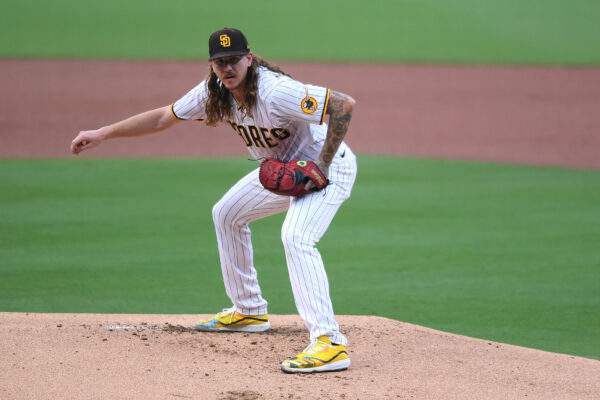
After surrendering six players for Clevinger’s services at the 2020 trade deadline, General Manager and President of Baseball Operations A.J. Preller is hoping to extract some value from a trade that can almost assuredly be categorized as a net loss. In Clevinger’s lone 2022 Spring Training start against San Francisco, he allowed eight runs over 1 2/3 innings, raising concerns about his ability to return as a 31-year-old recipient of two Tommy John surgeries.
When healthy, Clevinger is one of the more effective pitchers in baseball. He owns a career ERA of 3.19 and was a major boost for San Diego’s playoff push to end the 2020 regular season, where he pitched to a 2.84 ERA in 19 innings.
He’ll probably be brought along slowly as he works back to full strength. However, anything resembling value from Clevinger this season should be considered a positive as he looks to bolster an already formidable starting rotation.
[wpedon id=”49075″ align=”right”]
Blake Snell (no stats in 2022)
Snell, similar to Clevinger, has yet to throw a pitch so far this season after re-aggravating an adductor injury that cost him the final few weeks of the 2021 season. By all accounts, it seems as though the injury isn’t as serious as it was last season, though the Padres have been bringing him along slowly in an effort to get him fully healthy for the remainder of the 2022 season.
Snell has arguably the best “stuff” on the Padres pitching staff, with a fastball that consistently sits in the upper 90s and a wipeout slider. However, his 69 walks in 128 2/3 innings in 2021 marked the highest his walk rate has been since his rookie season in 2016 with Tampa Bay. He also continued to struggle to get deeper into games until a string of three starts in a row in August/September, registering at least seven innings, ten strikeouts, and two runs allowed or fewer.
If the Padres are to add that version of Snell to their starting rotation, they’ll likely form the best rotation in all of baseball. In his first rehab start with Fort Wayne last week, Snell threw four scoreless innings and struck out four. Snell will likely throw at least one or two more rehab starts before being inserted into the Padres rotation, at which point the team will have multiple decisions to make about roster allocation.
Sammy is a 2021 graduate/college baseball player with a degree in economics from Lewis & Clark College in Portland, Oregon. Currently, he resides in a suburb of Portland called Lake Oswego. Sammy previously wrote for EVT from November 2017-November 2019, and is back again as of April 2022.
In his free time, Sammy enjoys spending time outside, playing golf, and watching his hometown Padres.
The team should consider trading Darvish or Snell for a legitimate corner OF.